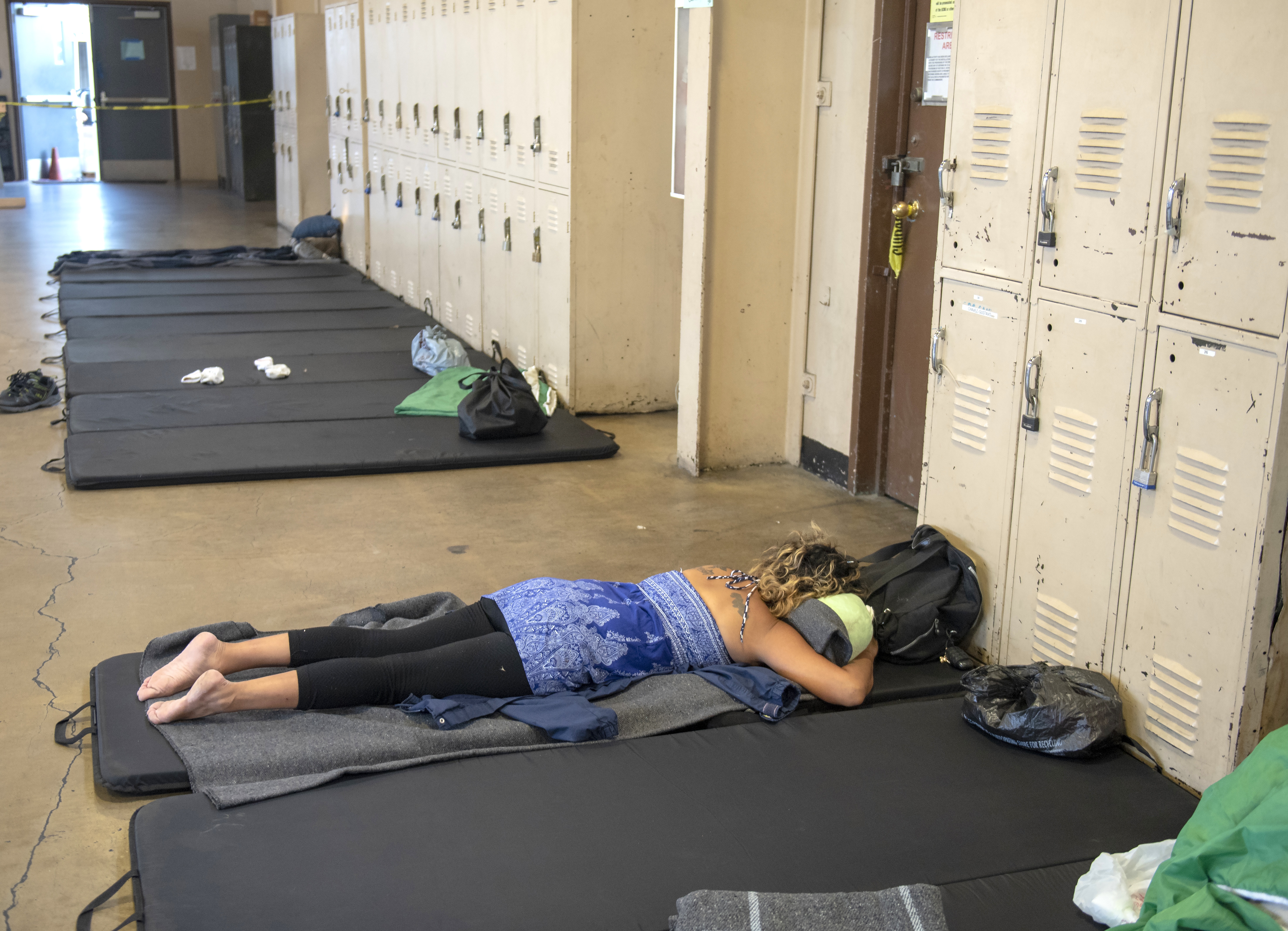Up to 200 homeless people will be back on the streets at night once Orange County armory shelter programs end Sunday morning
News that Saturday, July 14, would be the last night for homeless people to sleep at the California National Guard Armory in Santa Ana caught Kimberly Shagena by surprise.
“Geez Louise, that’s even sooner than I thought,” said Shagena, 52, who has spent every night for nearly eight months inside the cavernous military installation on Warner Avenue, bedding down on a mat on the ground with her belongings held close beside her.
“I thought it was closing on Sunday. It makes a difference, 24 hours.”
The reality of going back to sleeping on the streets or in their cars was one day closer.
Anxiety had already set in for Shagena and many others who have continued sleeping at the armory under a special 90-day extension of Orange County’s annual cold weather shelter program at the National Guard facilities in Santa Ana and Fullerton.
“Everybody was upset,” said Shagena. “They didn’t know where they were going to sleep, where they were going to go — same thing I’m worried about.”
On Thursday, the county sent a team of social service and health care workers to help connect people at the Santa Ana armory to such resources as food stamps, general relief and medical services.
Housing options were limited at the two county-run shelters. The Courtyard in Santa Ana, as of Thursday, had 43 available beds and Bridges at Kraemer Place in Anaheim had 13.
The county spent about $800,000 on the extension. The Fullerton program ended Wednesday because the military needed to use the facility. That last night, 78 people slept at the Brookhurst Street armory. Thursday’s crowd in Santa Ana numbered 138, and 36 sought help from the county workers.
Shagena, who is bipolar and hobbled from back surgery to repair degenerative discs, hopes to find a room to rent. She gets about $1,800 monthly in disability and worker’s comp payments but said it’s taken months to fix her finances after thieves hacked her bank account. A caretaker brought her to the armory in January.
Others are more uncertain of their future.
“I’ll probably go over to the Courtyard or something,” Victor Stepanenko, 50, said in between forkfuls of salad from Thursday night’s hot meal of salmon casserole. He is a former electrical engineer hurt by the recession and homeless now for five years.
“I’ve been trying to get back to work,” Stepanenko said. “This is crazy.”
Even though he doesn’t drink or do drugs, Stepanenko wants to explore getting into a sober living house because, he said, they have openings.
Frank Kim, Orange County’s executive officer, said the county is working with Santa Ana officials to find a site elsewhere in the city to relocate the Courtyard shelter from its Civic Center location, and expand the capacity.
The Courtyard sleeps about 400 people in a converted bus terminal. The Bridges shelter has 200 beds.
But nothing can develop fast enough, Kim said:
“We want to find a solution that makes everyone happy but the reality is it takes time.”
Finding shelter
The county and all 34 cities are involved in a civil rights lawsuit related to the clearing of homeless tent encampments at the Santa Ana River Trail in February. Officials are under pressure from U.S. District Court Judge David O. Carter to identify sites for additional emergency shelters around the county.
Lawyers representing the homeless plaintiffs said they will seek to suspend local ordinances that prevent homeless people from camping on the street if appropriate shelter can’t be provided. Undisclosed sites have been proposed.
Santa Ana and Anaheim residents and city officials feel that their cities have borne the brunt of trying to cope with the county’s homeless population, estimated at around 4,800 people. More than half are unsheltered.
Kim has been hearing those concerns almost daily since the river trail encampments were cleared of hundreds of homeless people. Most were placed in motels for 30 days. Many are back on the streets, while others are temporarily housed. Another tent encampment of about 200 people at the Santa Ana Civic Center was shut down in April.
At a court hearing earlier this year, Carter worried about what would happen after the expiration of the armory shelter programs — extended on an emergency basis by Gov. Jerry Brown and the state’s military department.
When the Fullerton armory closed Wednesday, the county scrapped a plan to transport people to the Santa Ana armory for the rest of the week.
“The sensitivity of communities is so high,” Kim said in a phone interview Thursday. “We’ve had issues with communities that have said we don’t want you to bring that population into our communities.”
At least one man staying at the Santa Ana armory planned to leave Orange County if a housing lead from Mercy House, the nonprofit that operates the armory shelter programs, didn’t pan out.
Gerald Broussard, originally from Los Angeles, said he wasn’t worried about his prospects. He also had a referral from an LA agency and has been able to find work in both counties.
Broussard only recently became homeless, his first experience of not having a place to stay, he said.
“I didn’t have any plans on staying here anyway, so it won’t affect me,” Broussard, 56, said of the armory closing. “I’m healthy. I’ve got people who will help me. But a lot of these people, all they have is the other homeless person that’s with them.”


















